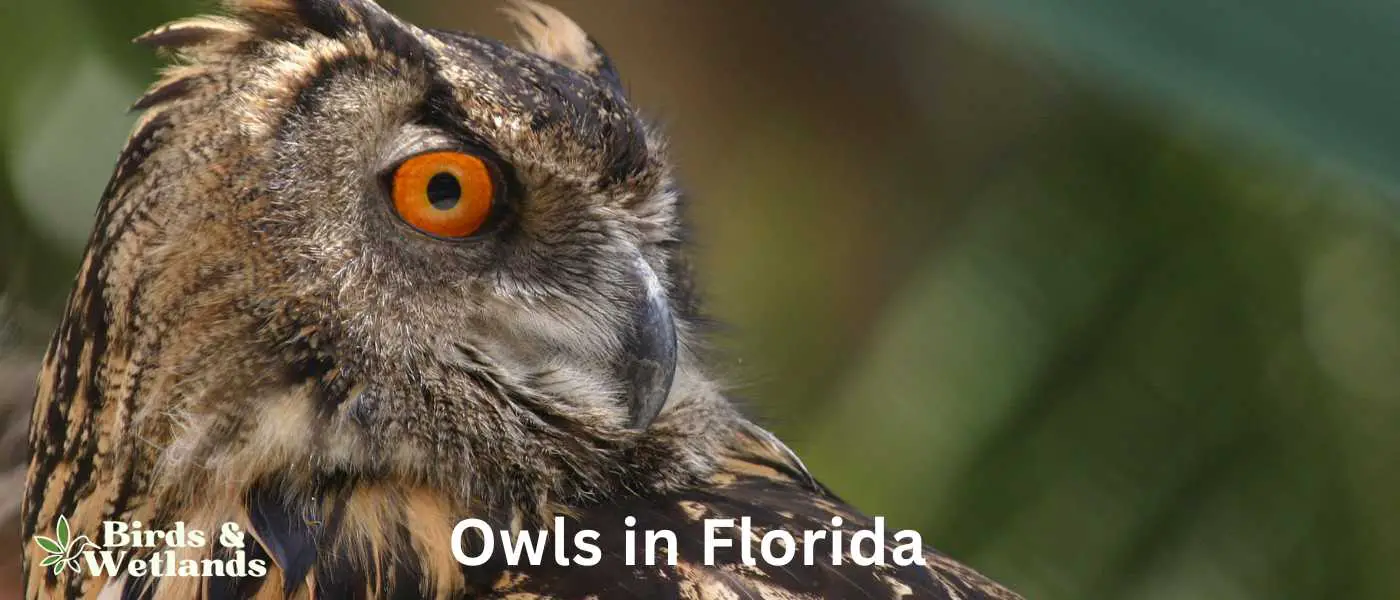In the rich and varied ecosystems of Florida, spanning from its sun-drenched beaches to its dense forests and expansive Everglades, thrives a unique array of owls. These twilight birds of prey serve a crucial role in the region’s biodiversity, contributing as formidable predators and vital links in their respective food chains.
Florida Owls
| Owl Species | Frequency in Florida | Presence in Florida | Where to Find in Florida |
|---|---|---|---|
| Great Horned Owl | High | Statewide | Everglades National Park, Homestead; Payne’s Prairie Preserve State Park, Micanopy |
| Barred Owl | High | Statewide | Corkscrew Swamp Sanctuary, Naples; Ocala National Forest |
| Eastern Screech Owl | High | Statewide | John Pennekamp Coral Reef State Park, Key Largo; Anastasia State Park, St. Augustine |
| Burrowing Owl | Moderate | Southern and Central Florida | Brian Piccolo Park, Cooper City; Cape Coral’s Burrowing Owl Festival site |
| Barn Owl | Moderate | Across Florida, primarily in Open Fields | Kissimmee Prairie Preserve State Park; Dinner Island Ranch Wildlife Management Area, Clewiston |
| Short-eared Owl | Low (Seasonal) | Coastal Areas and Open Fields | St. Marks National Wildlife Refuge, St. Marks; Honeymoon Island State Park, Dunedin |
| Northern Saw-whet Owl | Very Low (Seasonal) | Northern Florida in Winter | Apalachicola National Forest; St. George Island State Park |
| Snowy Owl | Extremely Rare (Seasonal) | Coastal Areas in Winter | Fort Pickens Area, Gulf Islands National Seashore, Pensacola |
Owl Species Found in Florida
Great Horned Owl (Bubo virginianus)

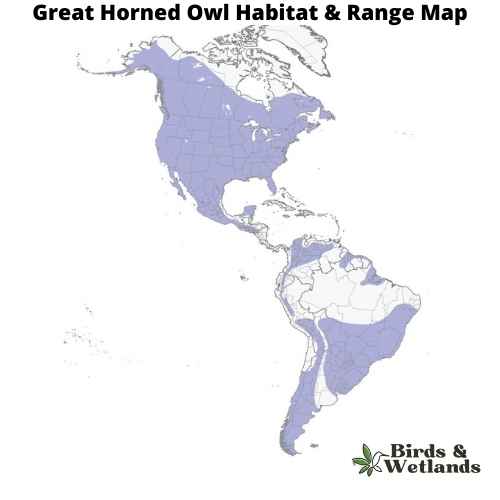
Great Horned Owl Sound
Scientific Name:Bubo virginianus
Length: 18.1-24.8 in
Wingspan: 39.8-57.1 in
Weight: 32.1-88.2 oz
The Great Horned Owl is a large owl with long wings and a large head. It’s one of the most common owls in North America.
Great Horned Owls are large, stocky birds with soft feathers that are gray to brown on their backs and white on their chests. Their faces are characterized by two black “ear” tufts, which can be raised or flattened depending on the owl’s mood. The eyes are yellow, orange, or red in color.
The habitat of the Great Horned Owl is a variety of different environments such as forests and deserts. They also live near water sources such as lakes, streams and rivers where they can hunt for fish.
The diet of the Great Horned Owl consists primarily of small mammals such as mice and rats; however they will also eat other rodents such as squirrels, rabbits and porcupines. They have been known to eat skunks too.
Eastern Screech-Owl (Megascops asio)
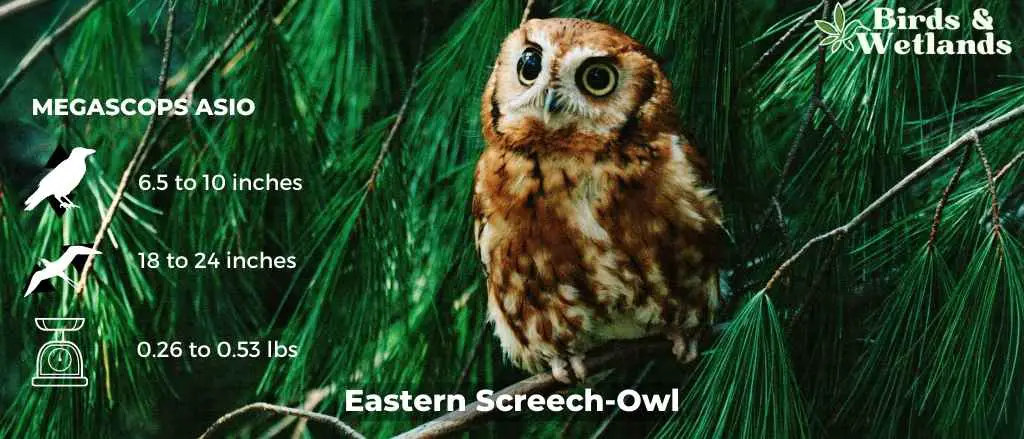
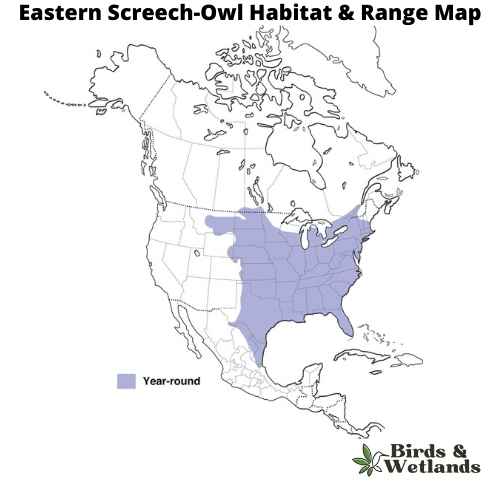
Eastern Screech-Owl Sound
Scientific Name: Megascops asio
Length: 6 to 10 in
Wingspan: 8 to 24 in
Weight: 4 – 8.5 oz
The Eastern Screech-Owl is a small owl species native to most wooded environments of the eastern half of North America, from the Canadian provinces to Florida and Texas.
Eastern Screech-Owls are relatively small and exhibit a complex pattern of gray or reddish-brown coloration, which provides excellent camouflage against tree bark.
These owls are known for their distinctive call, which is often described as a haunting trill or a whinny-like sound. Despite their name, they do not actually produce a “screech.”
Eastern Screech-Owls feed on a variety of prey, ranging from small mammals and birds to insects and even earthworms. It is primarily nocturnal, hunting at night from a low perch and swooping down onto prey.
Eastern Screech-Owls nest in tree cavities or abandoned woodpecker nests, but they readily adapt to nesting boxes where natural cavities are not available. They typically lay between 2 to 6 eggs, which are incubated primarily by the female.
Barred Owl (Strix varia)

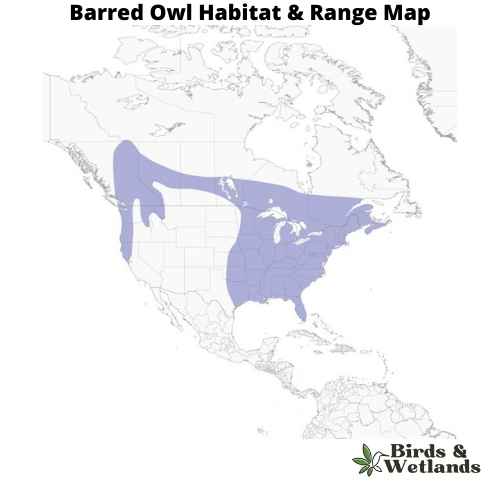
Barred Owl Sound
Scientific Name: Strix varia
Length: 40 to 63 cm (16 to 25 in)
Wingspan: 96 to 125 cm (38 to 49 in)
Weight: 468 to 1,150 g
The Barred Owl is a medium-sized owl with a barred pattern on its chest and belly. They have large yellow eyes that allow them to see well in low light conditions. Their ears are not very large which means they do not hear very well but they have excellent hearing abilities which allow them to detect sounds up to 1 mile away. Their feathers are brown and streaked with white, and they have black bars on their chests and wings.
Their habitats include forests, woodlands, orchards, parks, farmland and suburban backyards.
Barred Owls (also known as hoot owl) eat small mammals such as mice, rats and squirrels. They also eat insects such as beetles or grasshoppers. These owls hunt during the day when it is light out so that they can see their prey better than at night when they would be using senses other than sight like sound or smell to find their food source.
Barred owls are monogamous birds which means they mate for life. They build nests in trees or cavities on the ground and lay 2-4 eggs per year. The incubation period for these eggs lasts about 28 days before hatching takes place.
Barn Owl (Tyto alba)

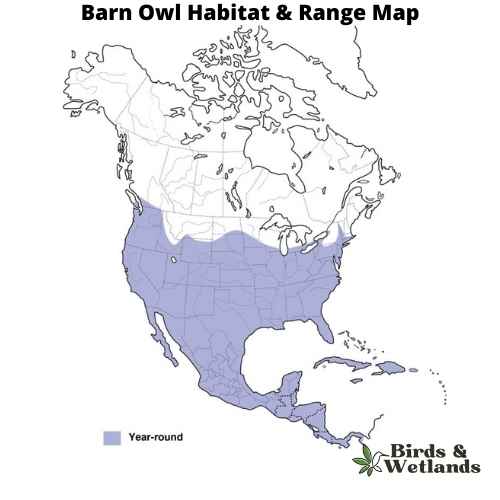
Barn Owl Sound
Scientific Name: Tyto alba
Length: 13 to 15 in
Wingspan: 31 to 37 in
Weight: 9.2 oz
The Barn Owl is a widespread species of owl known for its distinctive heart-shaped facial disc.
Barn Owls are medium-sized owls, they are pale overall with golden-brown wings and back, contrasted by a white face, chest, and belly. Their most notable feature is their heart-shaped facial disc, which helps channel sound to their ears.
Barn Owls are typically found in open habitats, including farmland, woodland, and marshes. They are named for their habit of nesting in human structures such as barns, church towers, and in the hollows of large trees. These owls are nocturnal, hunting at night and roosting during the day.
The diet of Barn Owls primarily consists of small mammals, particularly rodents such as mice and rats. They are known for their silent flight, which allows them to sneak up on their prey without detection.
Barn Owls have a unique nesting behavior. They do not build nests, but instead, lay their eggs directly on the bare surface of a secluded ledge or cavity. A female typically lays 4-7 eggs, and both parents help incubate the eggs and care for the chicks.
Burrowing Owl (Athene cunicularia)
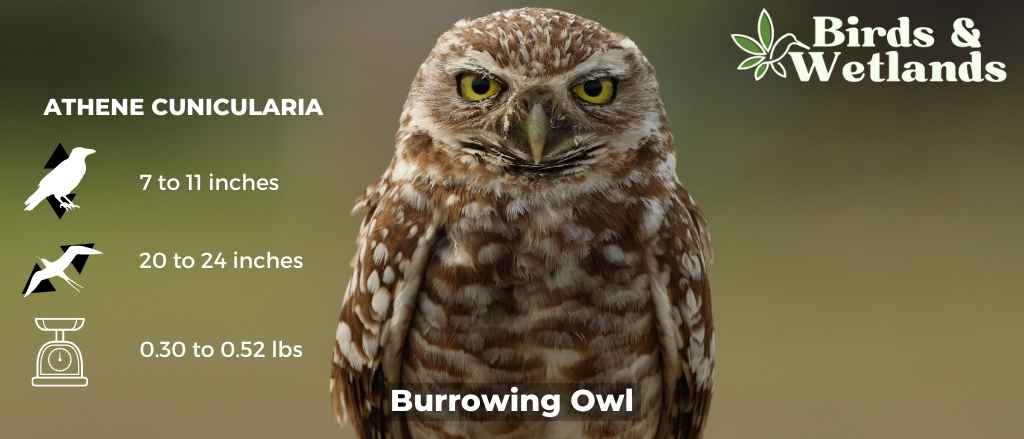
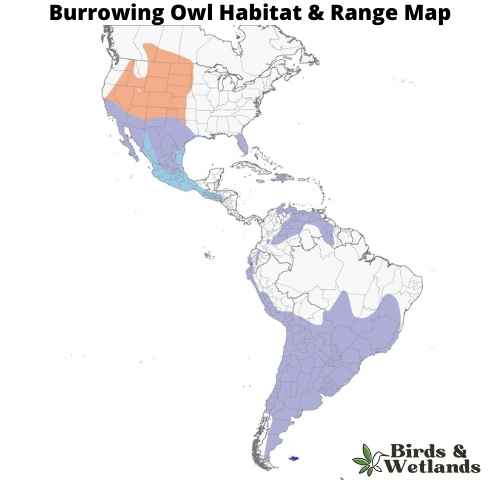
Burrowing Owl Sound
Scientific Name: Athene cunicularia
Length: 7–11 in
Wingspan: 20–24 in
Weight:5–8 oz
The Burrowing Owl is a small, long-legged species of owl found in North and South America. Known for its unusual habit of living in burrows in the ground.
Burrowing Owls have a rounded head with no ear tufts and bright yellow eyes. Their overall coloration is mottled brown and white with a distinct white “eyebrow” above each eye.
Their primary habitat includes open landscapes such as grasslands, deserts, agricultural areas, golf courses, and even airports. As their name suggests, these owls often reside in burrows, many of which are abandoned by prairie dogs, ground squirrels, or other burrowing animals. In some cases, they may also dig their own burrows.
Burrowing Owls diet consists mainly of small mammals and insects, but they also eat birds and reptiles.
Burrowing Owls have a unique nesting behavior. They lay their eggs in an underground burrow to protect them from predators and extreme weather. Clutch sizes range from 6 to 11 eggs, which are incubated for about a month before hatching.
Short-eared Owl (Asio flammeus)
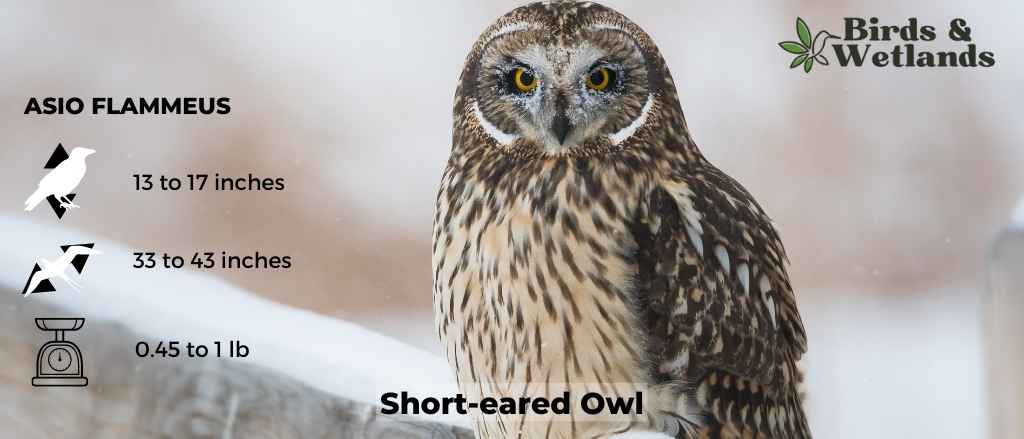
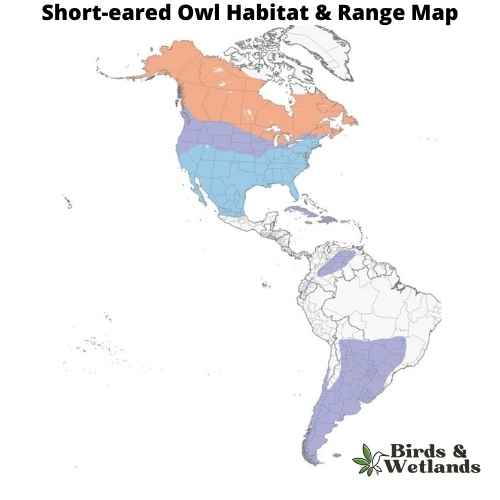
Short-eared Owl Sound
Scientific Name: Asio flammeus
Length: 13–17 in
Wingspan: 33 to 43 in
Weight: 7.3–16.8 oz
The Short-eared Owl is a medium-sized owl species with a wide distribution, found across North and South America, Europe, Asia, and many Pacific islands. Despite its name, the “ears” of the Short-eared Owl are not often visible, as they are small and tend to blend with the bird’s feathers.
The owls are predominantly brown with buff and white accents throughout their body and wings, and dark patches around their yellow eyes.
Short-eared Owls diet consists largely of small mammals, especially voles. However, they are opportunistic hunters and will also prey on a variety of other animals, including other birds, when available.
Their habitat is characterized by open areas like grasslands, marshes, and tundra. They nest on the ground, which is unusual for owls, and this makes them vulnerable to ground predators. As such, they often live in areas with tall grasses or other ground cover for protection.
Northern Saw-whet Owl (Aegolius acadicus)
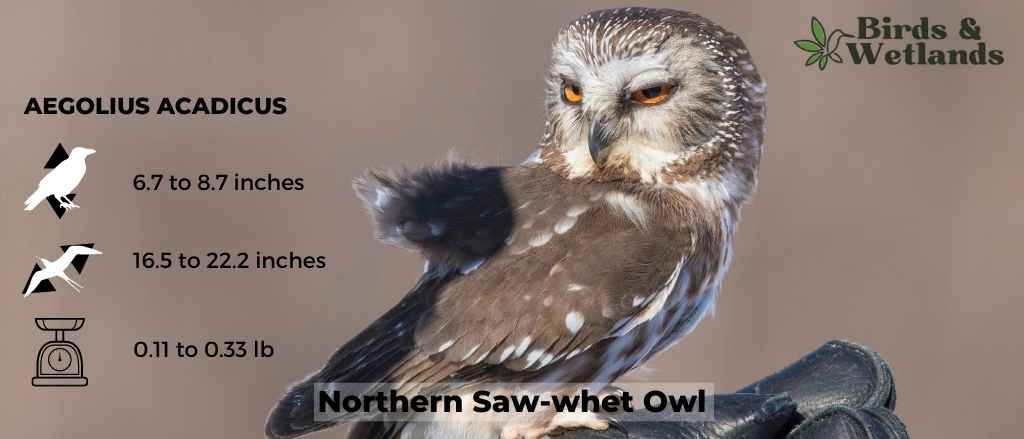
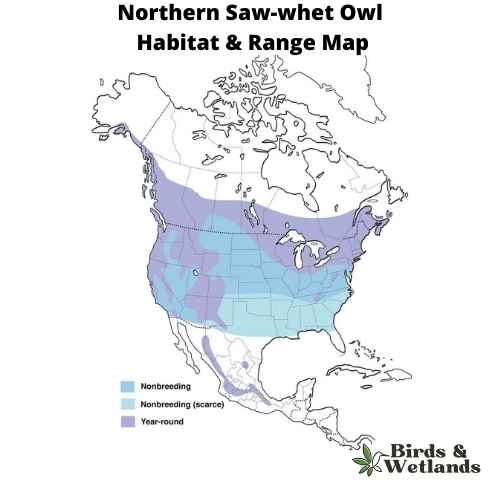
Northern Saw-whet Owl Sound
Scientific Name: Aegolius acadicus
Length: 17–22 cm (6.7–8.7 in)
Wingspan: 42–56.3 cm (16.5–22.2 in)
Weight: 54 to 151 g (1.9 to 5.3 oz)
The Northern Saw-whet Owl is a tiny, speckled gray owl and it’s one of the smallest owls in North America. It’s also known as the Little Owl or Wood Owl in some areas.
Northern Saw-whet Owls have dark brown eyes, white eyebrows, and yellow beak. It has brownish-grey feathers that are spotted with white. The owl’s legs are covered in feathers and appear nearly invisible when the bird is perched on a branch or tree.
In the winter they migrate south to warmer climates. They prefer to live in dense coniferous forest with large trees but will occasionally nest in shrubs or other vegetation that can protect them from predators.
The Northern Saw-whet Owl eats mice and voles (small rodents), small birds, frogs, salamanders, moles and shrews, but unlike most owls they chop their prey up and spread over a few meals. They will also eat insects like beetles and grasshoppers if they are available. It hunts from a perch at night using its excellent hearing to locate prey items within about 30 feet (9 meters) of its nest.
These owls nest in tree cavities usually located close to water sources such as lakes or rivers where they can find their food source (insects). They lay 2-4 eggs at one time which incubate for about 30 days before hatching.
Snowy owl (Bubo scandiacus)
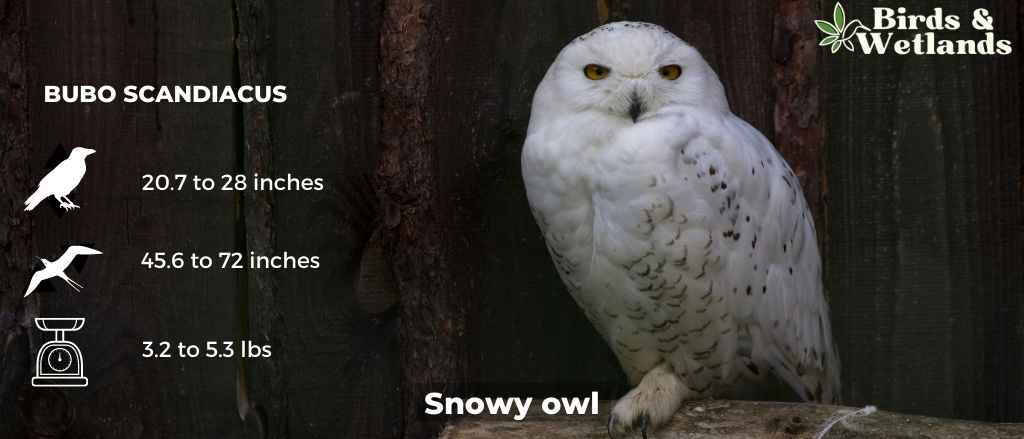
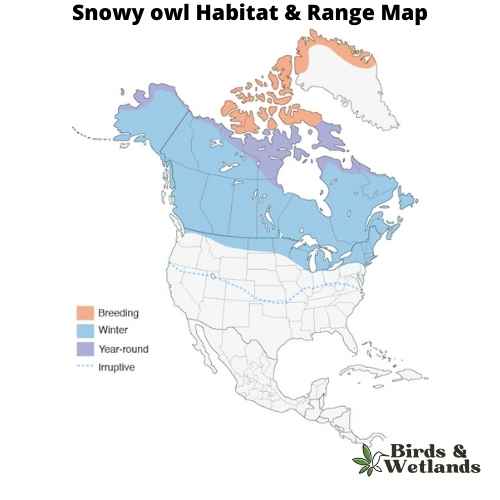
Snowy owl Sound
Scientific Name: Bubo scandiacus
Length: 20.7 to 28 in
Wingspan: 3 ft 10 in to 6 ft 0 in
Weight: 3.2lb to 5.3lb
The Snowy Owl, is of the most well-known species of owls, the Snowy Owl is renowned for its striking appearance and adaptations to its extreme environment.
Snowy Owls are medium sized birds that possess a rounded head, yellow eyes, and a black beak. The most distinctive feature of the Snowy Owl is its white plumage, which provides effective camouflage in its snowy habitat. Male Snowy Owls are often almost completely white, while females and younger owls have more extensive dark barring on their plumage.
Unlike many owl species, Snowy Owls are primarily diurnal, which means they are active during the day. This is an adaptation to life in the Arctic, where there can be 24 hours of daylight in the summer. Their diet mainly consists of small mammals, particularly lemmings, but they are known to eat a variety of animals including birds, fish, and even carrion when necessary.
Snowy Owls nest on the ground, usually on a mound or boulder. Their breeding success is closely tied to the availability of food, and in good years a single pair of owls can raise a large brood of chicks.
Where to Spot Florida’s Owls
Everglades National Park: One of the most biologically diverse areas in North America, this park is home to a variety of owl species, including the Barred Owl, Eastern Screech Owl, and the rare and tiny Elf Owl.
Corkscrew Swamp Sanctuary, Naples: This Audubon sanctuary’s ancient bald cypress forest is a haven for Barred Owls. The boardwalk trail provides excellent opportunities to spot these owls.
Ding Darling National Wildlife Refuge, Sanibel Island: This refuge on the Gulf Coast is home to various owl species, including the Great Horned Owl and the Barred Owl. During winter, Burrowing Owls can sometimes be seen as well.
Oscar Scherer State Park, Osprey: This park’s scrubby flatwoods are an ideal habitat for the threatened Florida Scrub-Jay, but you can also find the Great Horned Owl and Eastern Screech Owl here.
Kissimmee Prairie Preserve State Park, Okeechobee: This park’s expansive dry prairie habitat is a good spot to see the Burrowing Owl, particularly during the breeding season when these ground-nesting owls are more active during daylight hours. In Florida, nest boxes where owls hunt are used to provide habitat for owls, support the growth of young owls, and attract other owls as migratory species such as tiger owl and ghost owl.
| State | Main Owl Watching Sites |
|---|---|
| Georgia Owls | Okefenokee National Wildlife Refuge, Piedmont Park in Atlanta |
| Alabama Owls | Wheeler National Wildlife Refuge, Bankhead National Forest |
Tips on How to Spot Owls in Florida?
Know Your Owls: Florida is home to several owl species such as the Barred Owl, Eastern Screech Owl, Burrowing Owl, and Great Horned Owl. During certain times of the year, you may also spot the Short-eared Owl or the Northern Saw-whet Owl. Understand the habits and habitats of these owls to enhance your chances of spotting them.
Time of Day: Most owls are crepuscular (active at dawn and dusk) or nocturnal (active at night). Therefore, plan your bird watching activities accordingly. Burrowing Owls are an exception as they can be seen during the day around their burrow sites.
Where to Look: Different owl species favor different habitats. Barred Owls can often be found in wooded swamps and forests, while Burrowing Owls prefer open fields and grasslands. Great Horned Owls have a wider range and can be found in parks, forests, and sometimes even in urban areas.
Look for Signs: Look for signs of owl activity such as whitewash (droppings) on the ground, pellets, or feathers. Owls often regurgitate pellets that contain the indigestible parts of their prey like bones and fur.
Listen for Calls: Learn the distinctive calls of different owl species. This can help you locate owls even when they are well-camouflaged or active at night.
Equipment: A good pair of binoculars is essential for bird watching. A field guide to birds can also be helpful. If you plan to look for owls at night, consider using a red flashlight which is less disruptive to wildlife.
Join a Local Group: Consider joining a local bird watching group or club. These groups often organize birding trips and workshops, and can be a great source of information about where to spot owls.
Respect Nature: As with all wildlife, it’s important to respect owls and their habitats. Keep a respectful distance, don’t disturb nesting sites, and limit the use of playback calls as they can cause unnecessary stress to the birds.

